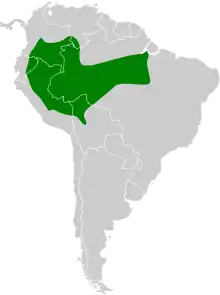Banded antbird
The banded antbird (Dichrozona cincta) – sometimes called banded antwren despite not being close to the true antwrens – is a species of bird in the family Thamnophilidae. It is the only member of the genus Dichrozona. Its natural habitat is subtropical or tropical moist lowland forests.
| Banded antbird | |
|---|---|
%253B_Jaci-Parana%252C_Porto_Velho%252C_Rond%C3%B4nia%252C_Brazil_02_(cropped).jpg.webp) | |
| A banded antbird at Porto Velho, Rondônia, Brazil. | |
| Scientific classification | |
| Domain: | Eukaryota |
| Kingdom: | Animalia |
| Phylum: | Chordata |
| Clade: | Dinosauria |
| Class: | Aves |
| Order: | Passeriformes |
| Family: | Thamnophilidae |
| Genus: | Dichrozona Ridgway, 1888 |
| Species: | D. cincta |
| Binomial name | |
| Dichrozona cincta (Pelzeln, 1868) | |
 | |
| Synonyms[2] | |
Taxonomy
The banded antbird was described by the Austrian ornithologist August von Pelzeln in 1868 and given the scientific name Cyphorhinus (Microcerculus) cinctus.[3] The present genus Dichrozona was erected by the American ornithologist Robert Ridgway in 1888.[5][10]
Subspecies
There are three subspecies:[11]
- Dichrozona cincta cincta (Pelzeln, 1868) – east Colombia, south Venezuela and northwest Brazil
- Dichrozona cincta stellata (Sclater, PL & Salvin, 1880) – east Ecuador and west Brazil
- Dichrozona cincta zononota Ridgway, 1888 – west central Brazil and north Bolivia
References
- BirdLife International (2016). "Dichrozona cincta". IUCN Red List of Threatened Species. 2016: e.T22701543A93835350. doi:10.2305/IUCN.UK.2016-3.RLTS.T22701543A93835350.en. Retrieved 11 November 2021.
- Osgood, Wilfred H. (1924). Catalogue of Birds of the Americas. Part III. Pteroptochidae — Conopophagidae — Formicariidae. Field Museum of Natural History. Zoological Series. Vol. 13. Chicago. pp. 165–166.
{{cite book}}: CS1 maint: location missing publisher (link) - Pelzeln, von August (1868). Zur Ornithologie Brasiliens (in German). Vol. 1. Wien: A. Pichler's Witwe & Sohn. pp. 47, 65–66.
- Sclater, P. L.; Salvin, O. (1880). "On new birds collected by Mr. C. Buckley in Eastern Ecuador". Proceedings of the Zoological Society of London. 48 (2): 160. doi:10.1111/j.1469-7998.1880.tb06545.x.
- Ridgway, Robert (1887). "Descriptions of new species and genera of birds from the Lower Amazon". Proceedings of the United States National Museum. 10 (660): 516–528 [524]. doi:10.5479/si.00963801.660.516.
- Riker, Clarence B.; Chapman, Frank M. (1891). "A list of birds observed at Santarem, Brazil (Continued)". The Auk. 8 (1): 29.
- Hellmayr, C. E. (1903). "Bemerkungen über neotropische Vögel". Journal für Ornithologie. 51 (4): 536–537. doi:10.1007/BF02361577. S2CID 9754426.
- Chapman, Frank M. (1917). The distribution of bird-life in Colombia: a contribution to a biological survey of South America. Bulletin of the American Museum of Natural History. Vol. 36. New York. p. 386. hdl:2246/1243.
{{cite book}}: CS1 maint: location missing publisher (link) - von Ihering, H. (1904). "O Rio Juruá". Revista do Museu Paulista. 6: 431–432.
- Peters, James Lee, ed. (1951). Check-list of Birds of the World. Vol. 7. Cambridge, Massachusetts: Museum of Comparative Zoology. p. 200.
- Gill, Frank; Donsker, David, eds. (2017). "Antbirds". World Bird List Version 8.1. International Ornithologists' Union. Retrieved 4 February 2018.
Further reading
- Ridgely, Robert S.; Tudor, Guy (1989). The Suboscine Passerines. The Birds of South America. Vol. 2. University of Texas Press. pp. 318–319; Pl. 22, Fig. 5. ISBN 978-0-292-77063-8.
- Helmayr, C. E. (1906). "Critical Notes on the Types of Little-Known Species of Neotropical Birds". Novitates Zoologicae. 13: 348–349.
- Hemayr, C. E. (1910). "The Birds of the Rio Madeira". Novitates Zoologicae. 17 (3): 361.
This article is issued from Wikipedia. The text is licensed under Creative Commons - Attribution - Sharealike. Additional terms may apply for the media files.
